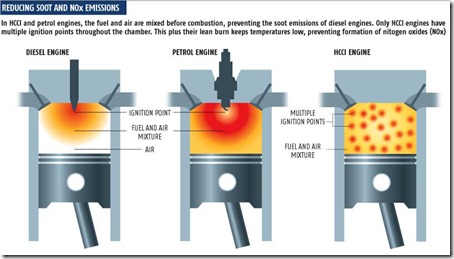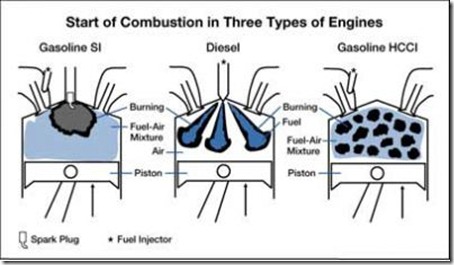Homogeneous charge compression ignition (HCCI) is a form of internal combustion in which well-mixed fuel and oxidizer (typically air) are compressed to the point of auto-ignition. As in other forms of combustion, this exothermic reaction releases chemical energy into a sensible form that can be transformed in an engine into work and heat.
Ever imagined an engine that will be as frugal and long lasting as a diesel motor while revving as high and sounding as smooth as a high strung petrol motor? How about running the same engine with a multitude of fuel options, or say an omnivorous engine? All this is very likely in the future. Read on as ICB’s inhouse tech expert gives you a overview of what is known as the HCCI engine.
If a petrol engine of 1.2 lit gives 15kmpl, the same size of diesel engine gives approximately 20kmpl. Petrol engines are SI (Spark Ignition) engines and diesels are CI (Compressed Ignition). Compression ratio of petrol engines is much lower than that of diesel engine.
HCCI has characteristics of the two most popular forms of combustion used in SI engines: homogeneous charge spark ignition (gasoline engines) and CI engines: stratified charge compression ignition (diesel engines). As in homogeneous charge spark ignition, the fuel and oxidizer are mixed together. However, rather than using an electric discharge to ignite a portion of the mixture, the density and temperature of the mixture are raised by compression until the entire mixture reacts spontaneously. Stratified charge compression ignition also relies on temperature and density increase resulting from compression, but combustion occurs at the boundary of fuel-air mixing, caused by an injection event, to initiate combustion.
HCCI engines have been shown to achieve extremely low levels of Nitrogen oxide emissions (NOx) without an after treatment catalytic converter. The unburned hydrocarbon and carbon monoxide emissions are still high (due to lower peak temperatures), as in gasoline engines, and must still be treated to meet automotive emission regulations.
 10:15 PM
10:15 PM
 sak
sak



 Posted in:
Posted in: 











0 comments:
Post a Comment